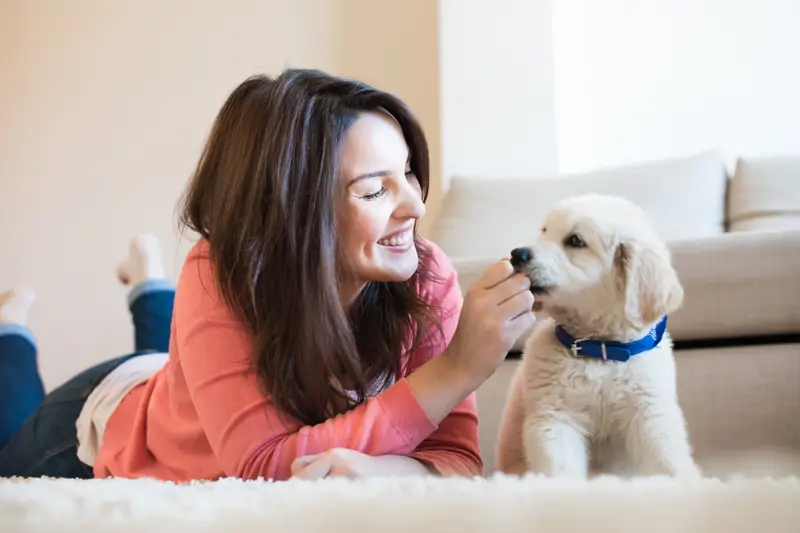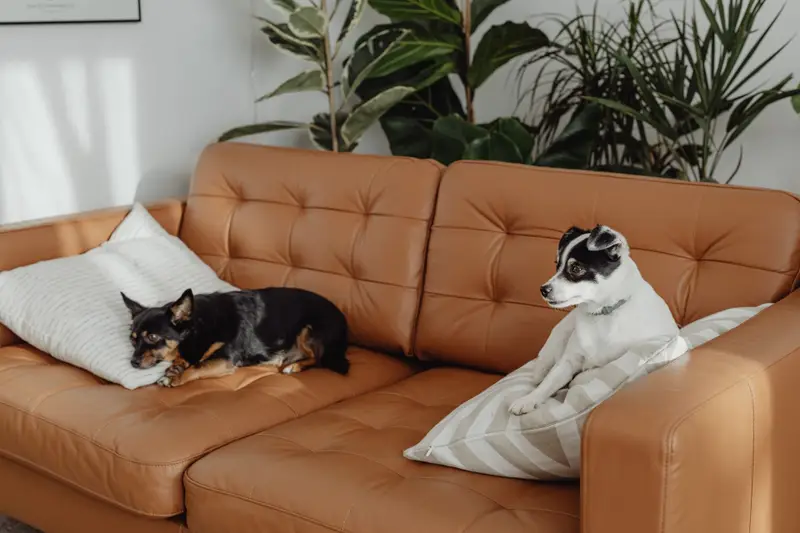A pet sitter meet and greet should cover introductions between sitter and pet, a home tour showing supplies and routines, discussion of pet personality and quirks, emergency protocols, and house rules. The goal is confirming compatibility and ensuring the sitter has everything they need to provide excellent care—not just making awkward small talk.
You scheduled the meet and greet. The sitter arrives in fifteen minutes. You suddenly realize you have no plan for what to actually cover, and you’re about to wing a conversation that determines whether your pet gets good care or whether you come home to chaos.
The meet and greet isn’t a formality—it’s your chance to assess whether this person can handle your pet, your home, and the inevitable weird situation that comes up. It’s also the sitter’s chance to decide if your pet is actually manageable or if you’ve downplayed the difficulty level.
Don’t waste it on surface-level chitchat. Here’s how to run a meet and greet that actually accomplishes something.
Before the Meet and Greet: What to Prepare
Don’t invite a sitter over with zero preparation. Do this first.
Clean the Key Areas (Not Everything)
You don’t need a spotless house, but tidy the spaces that matter:
Priority areas:
- Entrance and main walkways (so they’re not climbing over clutter)
- Pet supply areas (food storage, litter boxes, leash hooks)
- Kitchen (if they’ll have access during the sit)
- Guest room or sleeping area (if overnight sitting)
Don’t bother with:
- Rooms they won’t enter
- Deep cleaning that doesn’t affect pet care
- organizing just to impress
The sitter cares about functional access, not Instagram-worthy aesthetics.
Gather Pet Supplies and Documents
Have these ready to show:
Physical items:
- Current food and treats
- Medications with labels
- Leashes, harnesses, collars
- Favorite toys
- Carrier (in case of emergency vet visit)
- Litter box and supplies (for cats)
Documents to have available:
- Vaccination records
- Recent vet visit summaries
- Medical history (chronic conditions, allergies, past surgeries)
- Microchip information
- Emergency vet contact information
- Your regular vet’s contact information
You don’t need to hand them everything now, but having it ready shows you’re organized and prepared.
Prepare Your Pet
For anxious pets:
- Schedule the meet and greet during a calm time of day
- Exercise your dog beforehand so they’re not bouncing off walls
- Have treats ready for positive associations
- Don’t force interaction—let them approach at their own pace
For overly excited pets:
- Burn off energy before the sitter arrives
- Have a plan to redirect jumping or excessive enthusiasm
- Use commands they know to demonstrate training level
- Consider a brief leash for dogs who can’t contain themselves
For hiding cats:
- Don’t chase them out of hiding
- Show the sitter where they typically hide
- Explain this is normal behavior when strangers visit
- Let the cat observe from a distance
Your pet doesn’t need to perform perfectly—the sitter needs to see their actual personality.
Write Down Questions You Have
Don’t rely on memory. Prepare specific questions:
About their experience:
- How long have you been pet sitting?
- Have you cared for [breed/species] before?
- What’s the most challenging pet situation you’ve handled?
- How do you handle [specific issue your pet has]?
About their process:
- How do you structure visits? (quick check-ins vs. quality time)
- How often do you send updates?
- What’s your emergency protocol?
- Do you have backup if you get sick or have an emergency?
About logistics:
- What’s your cancellation policy?
- How far in advance do you need to book?
- What information do you need from me?
- How do you handle keys and home access?
For comprehensive interview questions, see our guide on questions to ask a pet sitter.
The Meet and Greet Structure (What to Cover and When)
Plan for 30-60 minutes depending on complexity. Here’s how to use that time.
Part 1: Initial Introductions (5-10 minutes)
Start with humans, then move to pets.
Greet the sitter at the door:
- Introduce yourself
- Confirm pronunciation of names (yours and your pet’s)
- Offer water or coffee if it’s a long meeting
- Give a brief overview of what you’ll cover
Introduce your pet:
- Let your pet approach naturally—don’t force it
- Explain your pet’s typical reaction to strangers
- Allow the sitter to use treats (bring some if your pet is food-motivated)
- Watch how the sitter approaches: Do they read body language? Respect boundaries? Force interaction?
What to observe:
- Does your pet seem comfortable or stressed?
- Does the sitter seem confident or nervous?
- Is the sitter’s energy level appropriate for your pet?
- Do they follow your lead or try to take over immediately?
If your pet is hiding, don’t panic. Explain this is normal and show the sitter where they typically retreat. Good sitters understand that cats especially need time to warm up.
For detailed guidance on first meetings, read our complete first-time pet sitter guide.
Part 2: Home Tour (15-20 minutes)
Walk them through everything they need to know about your home.
Stop 1: Pet feeding area
- Show where food is stored
- Demonstrate portion sizes with actual measuring tools
- Point out treats and when to use them
- Explain feeding schedule and any dietary restrictions
- Show water bowls and refresh frequency
Stop 2: Pet bathroom area
- For dogs: show door they use, yard boundaries, poop bag location
- For cats: show litter box location, litter storage, scooping routine
- Explain normal bathroom frequency
- Show cleaning supplies for accidents
Stop 3: Exercise and play areas
- Show where leashes, harnesses, toys are stored
- Explain walk routes or play preferences
- Demonstrate how to use any equipment
- Point out exercise restrictions or safety concerns
Stop 4: Sleeping areas
- Show where your pet sleeps
- Explain bedtime routine
- Point out comfort items (favorite blankets, toys)
- Clarify furniture rules (allowed on couch? bed?)
Stop 5: Medication and health supplies
- Show where medications are stored
- Demonstrate administration technique if needed
- Explain what each medication does
- Show first aid supplies and pet carrier location
Stop 6: Emergency information
- Point out where you’ll leave written instructions
- Show location of emergency contacts
- Explain when to contact you vs. act immediately
- Discuss Petme Protection Plan coverage (up to $20,000 in emergency vet expenses on every booking)
Stop 7: House-specific quirks
- Demonstrate alarm system
- Show tricky locks or sticky doors
- Explain thermostat and lighting preferences
- Point out any hazards (basement stairs, pool, etc.)
For comprehensive home tour guidance, read our pet sitter home tour article.
Part 3: Pet Personality and Behavior Deep Dive (10-15 minutes)
This is where you get specific about who your pet actually is.
Personality overview:
- Is your pet social, shy, independent, clingy, anxious, confident?
- How do they typically react to changes in routine?
- What makes them happy? What stresses them out?
- Do they have separation anxiety or other behavioral issues?
Behavioral quirks:
- Do they counter-surf, door-dash, dig, scratch furniture?
- Are they reactive to sounds (doorbell, garbage trucks, fireworks)?
- Do they resource guard (food, toys, furniture)?
- What commands do they know and actually respond to?
Social behavior:
- How do they interact with other dogs or cats?
- Are they good with strangers or do they need time to warm up?
- Do they have favorite people or places?
- Any aggression or fear-based reactions to watch for?
Signs of stress or illness:
- What does stress look like in your pet? (hiding, pacing, excessive vocalization, loss of appetite)
- What’s “normal” behavior vs. concerning behavior?
- Red flags that require immediate vet attention
- Changes in eating, drinking, or bathroom habits to monitor
Be honest here. Don’t downplay anxiety, aggression, or medical issues. Good sitters can handle challenges—they can’t handle surprises.
If your pet has specific behavioral needs, share relevant resources like our guides on handling shy cats or dog behavior for sitters.
Part 4: Routine Walkthrough (10-15 minutes)
Walk the sitter through a typical day, hour by hour if needed.
Morning routine:
- What time does your pet wake up?
- First bathroom break or litter box check
- Breakfast time and portion
- Morning walk duration and route (for dogs)
- Morning play session expectations
Midday routine:
- Lunch if applicable
- Midday walk or exercise
- Alone time behavior (do they sleep, play, pace?)
- Any medication given during the day
Evening routine:
- Dinner time and portion
- Evening walk or play session
- Last bathroom break timing
- Bedtime routine and where they sleep
- Overnight behavior (do they wake you up? need middle-of-night bathroom breaks?)
Variable routine elements:
- How flexible is the schedule? (rigid vs. adaptable)
- What happens if timing is off by 30 minutes?
- Weekend vs. weekday differences
- Weather-related adjustments
The more specific you are, the better the sitter can replicate your routine and minimize stress for your pet.
Part 5: House Rules and Logistics (5-10 minutes)
Cover the practical boundaries and expectations.
Guest policies:
- Can they have visitors?
- Overnight guest rules
- Other people who might stop by (cleaners, lawn service, neighbors)
Off-limit areas:
- Rooms they shouldn’t enter
- Furniture restrictions
- Spaces your pet shouldn’t access
Amenities and supplies:
- What they can use (kitchen, Wi-Fi, TV, bathroom)
- Food they’re welcome to
- Cleaning supplies and where to find them
Communication preferences:
- How often you want updates
- Preferred method (text, photo, call)
- Your availability and time zone
- Emergency contact protocol
Security expectations:
- Locking doors and setting alarms
- Camera disclosure (if applicable)
- Key handling and home access
- What to do if they get locked out
For detailed house rules guidance, read our pet sitter house rules article.
Part 6: Questions and Concerns (5-10 minutes)
Give the sitter space to ask questions and voice concerns.
Common sitter questions:
- Is your pet good with [specific situation]?
- What happens if they refuse to eat or seem off?
- Do you have backup supplies if something runs out?
- How do I handle [specific behavior] if it happens?
- What’s your budget for emergency vet care? (mention Petme Protection Plan coverage here)
Red flags to watch for:
- Sitter doesn’t ask any questions (either not paying attention or doesn’t care)
- Sitter seems overwhelmed or hesitant about your pet’s needs
- Sitter makes promises that sound too good to be true
- Sitter doesn’t take notes or seems dismissive of details
Green flags:
- Asks specific, thoughtful questions
- Takes notes during the tour
- Seems genuinely interested in your pet’s personality
- Offers suggestions based on experience
- Asks for clarification on anything unclear
If something feels off, trust your gut. This is the time to decide if this person is the right fit.
Your inbox needs this
Subscribe to the Petme newsletter for weekly updates with pet care tips, tales, and member-only perks.

What to Observe During the Meet and Greet
Pay attention to dynamics, not just words.
How Your Pet Reacts
Positive signs:
- Approaches the sitter willingly (even if cautiously)
- Accepts treats from them
- Shows relaxed body language (loose tail, soft eyes, normal posture)
- Engages in play or interaction
- Returns for more attention after initial curiosity
Neutral signs (not bad, just cautious):
- Keeps distance but watches curiously
- Sniffs the sitter but doesn’t approach fully
- Hides initially but peeks out later
- Needs encouragement to interact
Warning signs:
- Aggressive behavior (growling, snapping, hissing)
- Extreme fear (hiding and refusing to emerge, shaking, panicked attempts to escape)
- Stress signals (excessive panting, drooling, tucked tail, pinned ears)
- Complete shutdown (won’t move, frozen in place)
One bad meet and greet doesn’t necessarily mean it won’t work—some pets need multiple interactions to warm up. But if your pet shows fear or aggression repeatedly, find a different sitter.
How the Sitter Interacts
Positive signs:
- Reads your pet’s body language correctly
- Respects boundaries (doesn’t force interaction)
- Uses appropriate energy level for your pet’s personality
- Asks before touching or picking up your pet
- Adjusts approach based on your pet’s comfort level
- Takes notes or remembers details without prompting
Neutral signs:
- Slightly awkward with your pet initially but improves
- Asks lots of questions to clarify expectations
- Seems nervous but respectful
Warning signs:
- Ignores your instructions or pet’s body language
- Forces interaction when your pet pulls away
- Seems impatient with nervous pets
- Dismissive of your concerns or house rules
- Claims they’ve “never had a problem with any animal” (unrealistic)
- Doesn’t ask questions or take notes
Trust your instincts. If something feels wrong, it probably is.
After the Meet and Greet: Next Steps
The meeting’s over. Now what?
If It Went Well
What to do:
- Confirm the booking through Petme
- Send written instructions and emergency contact list
- Share any additional information (gate codes, alarm details, etc.)
- Schedule a trial visit if possible (sitter comes for one walk or feeding while you’re still in town)
- Add sitter’s contact info to your phone
- Prepare your home according to the home tour checklist
Trial visit benefits:
- Your pet gets another interaction with the sitter before you leave
- Sitter practices your routine with you available for questions
- You can observe how they handle tasks independently
- Identifies any confusion or forgotten details
- Builds confidence for both of you
If you’re using a pet sitter for the first time, a trial visit significantly reduces stress for everyone.
If You’re Unsure
What to do:
- Thank the sitter for their time
- Tell them you need to think about it or meet with other candidates
- Don’t book immediately just to avoid awkwardness
- Review notes and gut feelings honestly
- Consider scheduling a second meet and greet if your pet was unusually stressed
- Look for other sitters on Petme who might be a better fit
Questions to ask yourself:
- Did my pet seem comfortable or stressed?
- Did the sitter seem confident with my pet’s needs?
- Did they follow instructions during the tour?
- Do I trust them to handle emergencies appropriately?
- Would I feel comfortable leaving my pet with them for a week?
If you can’t answer yes to most of these, keep looking.
If It Went Poorly
What to do:
- Thank the sitter professionally
- Be honest but kind: “I don’t think it’s the right fit” is sufficient
- Don’t provide excessive detail unless they ask
- Continue searching for someone better suited
- Don’t settle out of desperation—keep looking
Common reasons for a bad match:
- Pet showed extreme fear or aggression
- Sitter seemed unprepared or dismissive
- Communication styles didn’t align
- Experience level didn’t match your needs
- House rules or pet care expectations were too different
A bad meet and greet isn’t a failure—it’s the system working. Better to know now than after you’ve left town.
Special Situations: Adapting the Meet and Greet
Not all pets and situations are standard. Adjust accordingly.
Multiple Pets
Additional considerations:
- Show how pets interact with each other
- Explain feeding separation if needed (one eats faster, food aggression, dietary differences)
- Demonstrate dynamics (who’s dominant, who’s submissive, who needs space)
- Point out conflict triggers and how to prevent them
- Clarify individual personalities (they’re not interchangeable)
Time needed: Add 10-15 minutes per additional pet
Read our guide on pet sitting for multi-pet households for detailed management strategies.
Pets with Medical Needs
Additional considerations:
- Demonstrate medication administration (pills, injections, topical treatments)
- Have sitter practice giving medication during meet and greet
- Explain what side effects to watch for
- Show how to monitor vital signs if relevant (temperature, glucose, etc.)
- Discuss emergency thresholds (when to call vet immediately)
Time needed: Add 15-20 minutes for complex medical routines
Ensure the sitter has experience with your pet’s specific condition or is willing to learn. Don’t assume they know how to give insulin injections just because they’ve pet sat before.
Anxious or Reactive Pets
Additional considerations:
- Explain triggers in detail (sounds, movements, other animals)
- Demonstrate calming techniques that work
- Show safe spaces where your pet retreats
- Discuss whether sitter should follow your pet or let them come out on their own
- Explain what “normal anxiety” looks like vs. concerning distress
Time needed: Add 10-15 minutes
Be brutally honest about your pet’s anxiety level. A sitter who’s never handled anxious pets will struggle—better to find someone experienced.
For specific guidance, share our articles on preparing your dog for a sitter and preparing your cat for a sitter.
Puppies or Kittens
Additional considerations:
- Explain house training status and accident frequency
- Show where cleaning supplies are for inevitable messes
- Demonstrate play boundaries (what’s too rough, bite inhibition training)
- Discuss teething behavior and what they can/can’t chew
- Explain energy levels and exercise needs
Time needed: Add 10 minutes
Puppies and kittens are higher maintenance than adults. Make sure your sitter has experience with young animals and understands the increased supervision needed.
Senior Pets
Additional considerations:
- Explain mobility limitations (stairs, jumping, walking distance)
- Show how to assist with movement if needed
- Discuss bathroom frequency and accidents
- Point out signs of pain or discomfort
- Explain any cognitive changes (confusion, disorientation)
Time needed: Add 10 minutes
Senior pets often have unpredictable needs. Make sure your sitter understands that flexibility and observation are critical.
For senior-specific care, check our guides on caring for senior cats and caring for senior dogs.
Meet and Greet Checklist (Print This)
Use this checklist to ensure you cover everything:
Before the Sitter Arrives
- ☐ Clean pet care areas and walkways
- ☐ Gather pet supplies and documents
- ☐ Exercise or calm your pet
- ☐ Write down questions to ask
- ☐ Prepare emergency contact information
During the Meet and Greet
- ☐ Introduce yourself and the sitter
- ☐ Allow pet and sitter to interact naturally
- ☐ Complete home tour (feeding, bathroom, exercise, sleep, medication, emergency)
- ☐ Discuss pet personality and behavioral quirks
- ☐ Walk through daily routine hour-by-hour
- ☐ Cover house rules and boundaries
- ☐ Review communication expectations
- ☐ Share emergency protocol and vet contacts
- ☐ Mention Petme Protection Plan coverage ($20,000 emergency vet expenses)
- ☐ Answer sitter’s questions
- ☐ Observe pet’s comfort level with sitter
- ☐ Observe sitter’s interaction style
After the Meet and Greet
- ☐ Decide if it’s a good fit
- ☐ Confirm booking or continue searching
- ☐ Send written instructions and contacts
- ☐ Schedule trial visit if possible
- ☐ Prepare home for the sit
- ☐ Add sitter’s contact info to phone
Common Meet and Greet Mistakes
Don’t sabotage yourself with these errors.
Rushing through it: Meet and greets take time. Don’t squeeze it into 15 minutes between other commitments. Block off an hour and give it full attention.
Not preparing questions: You’ll forget half of what you meant to ask if you don’t write it down. Prepare in advance.
Sugarcoating your pet’s issues: If your dog is reactive or your cat hides for days, say so. Surprises don’t help anyone.
Assuming they’ll remember everything: Even experienced sitters can’t remember every detail from one conversation. Write things down and give them copies.
Ignoring red flags: If something feels off about the sitter or how your pet reacts, don’t ignore it. Trust your instincts.
Not observing interactions: Pay attention to how the sitter approaches your pet. Do they read body language? Respect boundaries? This tells you how they’ll behave when you’re gone.
Skipping the home tour: Don’t just talk in the living room. Walk them through your actual space so they see where everything is.
Finding Sitters Worth Meeting
On Petme, you can filter sitters by experience level, read detailed reviews, and see how they’ve handled situations similar to yours.
Look for sitters who:
- Have experience with your pet’s breed or species
- Ask good questions during initial messages
- Have reviews mentioning thoroughness and attention to detail
- Show up on time to the meet and greet prepared to take notes
- Seem genuinely interested in your pet’s personality
Find experienced pet sitters on Petme who understand that the meet and greet is where good pet care actually starts.
Every Petme booking includes automatic coverage through the Petme Protection Plan, providing up to $20,000 in emergency veterinary expenses.
FAQ: Pet Sitter Meet and Greet
How long should a pet sitter meet and greet last?
Plan for 30-60 minutes depending on your pet’s complexity. Simple situations (one healthy adult pet, straightforward routine) take 30-40 minutes. Multiple pets, medical needs, or anxious animals need 45-60 minutes or longer.
What should I ask during a pet sitter meet and greet?
Ask about their experience with your pet’s breed, how they handle emergencies, their typical visit structure, update frequency, backup plans if they’re unavailable, and how they’ve handled challenging situations. See our complete interview questions guide.
Should I do a meet and greet before booking?
Yes, always. Meet and greets let you assess compatibility between sitter and pet, demonstrate your home and routines, clarify expectations, and identify any concerns before you’re committed.
What if my pet hides during the meet and greet?
This is normal, especially for cats. Show the sitter where your pet typically hides, explain this is expected behavior, and don’t force interaction. Good sitters understand that many pets need time to warm up.
How do I know if a meet and greet went well?
Positive signs include: your pet seemed comfortable (even if cautious), the sitter asked thoughtful questions, they took notes, they respected boundaries, you felt confident in their abilities, and both you and the sitter seemed aligned on expectations.
Should I pay for a meet and greet?
Many professional sitters charge for meet and greets (typically $20-50) since it’s their time and expertise. Some waive the fee if you book with them. Clarify this when scheduling.
Can I do a virtual meet and greet instead?
You can, but in-person is better. Virtual meetings don’t show how your pet reacts to the sitter, don’t allow for hands-on demonstrations, and don’t give the sitter familiarity with your home layout.
What if I don’t like the sitter after the meet and greet?
Thank them professionally, tell them you’re considering other options, and continue your search. Don’t book out of politeness or desperation—find someone you actually trust.
The meet and greet isn’t a formality—it’s your best chance to prevent problems before they happen.
Invest the time. Ask the questions. Observe the interactions. Trust your instincts.
Your pet deserves a sitter who gets them, and you deserve peace of mind knowing you picked the right person.











